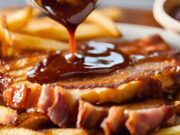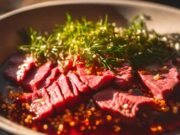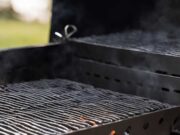Mastering the art of BBQ can be a rewarding experience; however, achieving perfectly cooked meat requires more than mere intuition.
A meat thermometer is essential for this process. This guide will provide you with all the information necessary for effectively using a meat thermometer, including an overview of the different types available, food safety practices, and how to achieve ideal doneness.
Whether you are a seasoned pitmaster or just beginning your journey, proper temperature monitoring is crucial for preparing delicious and safe meals. Prepare to elevate your BBQ skills to a new level.
Key Takeaways:
- “Using a meat thermometer for BBQ is crucial for ensuring proper doneness and preventing foodborne illnesses.”
- Knowing the best techniques for insertion, timing, and ideal temperature ranges for different meats can help you achieve accurate readings and perfect BBQ every time.
- “Avoid common mistakes such as inserting in the wrong part of the meat and not allowing for resting time. Regular cleaning, maintenance, and calibration are also important for accurate readings.”
Understanding Meat Thermometers
Understanding meat thermometers is essential for any grilling enthusiast. These devices enable you to accurately measure the internal temperature of your food, ensuring it is safe to eat while also enhancing the flavor and texture of the meat.
What is a Meat Thermometer?
A meat thermometer is a specialized device designed to measure the internal temperature of cooked meats, ensuring they reach a safe level to prevent foodborne illnesses while also optimizing flavor and texture.
By accurately gauging the temperature, this tool plays a crucial role in your culinary practices, helping you achieve the desired doneness while safeguarding health. For instance, poultry should be cooked to an internal temperature of 165°F, while ground meats like beef and pork should reach at least 160°F. Steaks and roasts are best enjoyed when they reach around 145°F for medium rare.

Modern options often incorporate advanced technology, such as digital displays and wireless connectivity, providing you with real-time temperature readings and alerts that enhance both convenience and precision in cooking.
Types of Meat Thermometers
There are several types of meat thermometers available on the market, including analog, digital, and Bluetooth models, each offering unique features that cater to various cooking styles and preferences. Understanding these differences can significantly enhance your cooking experience.
Analog thermometers provide a straightforward design and require no batteries, making them reliable for rustic kitchens; however, achieving precise readings may take some practice. In contrast, digital thermometers deliver quick and accurate readings, with many models equipped with backlit displays for easier visibility in low-light conditions.
The convenience of Bluetooth thermometers is also noteworthy, as they allow you to monitor cooking temperatures from a distance and connect to your smartphone for alerts, making them an ideal choice for multitaskers. While Bluetooth models offer technological advantages, it is important to consider that they may require charging and could occasionally encounter connectivity issues.
Why Use a Meat Thermometer for BBQ?
Utilizing a meat thermometer for BBQ is not merely a convenience; it is an essential practice that ensures your meats reach the appropriate internal temperature. This is crucial for food safety and for achieving the desired level of doneness.
Ensures Proper Doneness
One of the primary reasons to use a meat thermometer is to ensure that the meat is cooked to the appropriate doneness, which can range from rare to well done based on your personal preference and the type of meat being prepared.
Understanding the specific temperature benchmarks for different meats is essential for both flavor and food safety. For instance, chicken and turkey should reach an internal temperature of 165°F to effectively eliminate harmful bacteria; ground meats also need to achieve this temperature. If you prefer steak, a fillet cooked to 130°F will give you a medium-rare result, with variations for those who enjoy it more well done. Fish, on the other hand, should ideally be cooked to 145°F.
Utilizing a reliable meat thermometer not only helps you achieve these precise temperatures but also minimizes the risk of undercooked meat, ensuring that every meal is both safe and delicious.
Prevents Foodborne Illnesses
Using a meat thermometer effectively prevents foodborne illnesses by ensuring that meat reaches a safe temperature, thereby eliminating harmful bacteria that can thrive in undercooked food.
This proactive measure is essential, particularly considering that the Centers for Disease Control and Prevention (CDC) estimates approximately 48 million people in the United States suffer from foodborne illnesses each year, with around 128,000 hospitalizations resulting from these preventable infections.
Undercooked meats, such as poultry and ground beef, are notorious contributors to these statistics, often harboring pathogens like Salmonella and E. coli. By utilizing a thermometer to check internal temperatures, you can significantly reduce the risk of experiencing symptoms such as nausea, abdominal cramps, and diarrhea associated with these harmful bacteria.
Ultimately, employing such a simple tool can safeguard the health of individuals and families, promoting safer cooking practices in both homes and commercial kitchens.
How to Use a Meat Thermometer Correctly
To achieve optimal results when using a meat thermometer, it is crucial for you to understand the proper techniques for insertion and temperature monitoring throughout the cooking process.
These practices can significantly influence both food safety and quality.
Best Techniques for Insertion
The best techniques for inserting a meat thermometer into meat involve locating the thickest part of the cut while ensuring that it does not come into contact with bone or fat for an accurate temperature reading.
For chicken, insert the thermometer into the inner thigh area, pushing it through the thickest part without touching the bone, as this is where the meat takes the longest to cook. The same principle applies when cooking turkey; targeting the inner thigh will provide the most reliable reading.
In terms of steak, position the thermometer in the center of the thickness, angling it toward the middle for optimal accuracy. Additionally, visual cues, such as observing an even coloration or quickly checking the temperature, will assist in identifying the best point for secure insertion.
Timing and Monitoring
Timing and monitoring are critical when using a meat thermometer. Checking the temperature at the appropriate moments will help ensure your meat is cooked to perfection without the risk of overcooking.
This level of precision not only enhances the flavor and texture of your dish but also protects against foodborne illnesses. It is essential to check the temperature at the beginning, halfway through, and near the end of the cooking process to observe how the heat penetrates the meat.
For optimal results, ensure that you insert the probe into the thickest part of the meat, avoiding bones or fat that could provide misleading readings. Paying attention to these key moments will result in juicy, perfectly cooked meat every time, allowing for a safe and satisfying dining experience.
Ideal Temperature Ranges for Different Meats
Understanding the ideal temperature ranges for various meats is essential for achieving perfect doneness and ensuring food safety. Each type of meat requires specific internal temperatures to be safely consumed, making it important to familiarize yourself with these guidelines.
Poultry (Chicken, Turkey)
When cooking poultry such as chicken and turkey, it is essential to ensure that the internal temperature reaches at least 165°F. This temperature is critical, as it effectively kills harmful bacteria, making the meat safe for consumption.
You can achieve this temperature through various cooking methods, each offering its own unique advantages. For example, roasting allows for an even cook, resulting in succulent meat with crispy skin—ideal for festive occasions or family gatherings. Conversely, grilling imparts a delightful smoky flavor that enhances the overall taste experience.
Regardless of the method you choose, using a reliable meat thermometer is crucial. It not only provides peace of mind but also helps prevent overcooking, which can lead to dry and unappetizing poultry. By mastering these techniques, you can elevate your poultry dishes to restaurant-quality meals right in your own kitchen.
Beef (Steak, Ground Beef)
Beef, including steak and ground beef, necessitates different internal temperature benchmarks for optimal doneness. Steak typically ranges from 130°F for medium-rare to 160°F for well-done, while ground beef must always reach at least 160°F.
Understanding these cooking preferences can significantly enhance your dining experience by ensuring that the meat achieves the juicy tenderness and rich flavor many enjoy. For steak enthusiasts, the level of doneness not only affects texture but also influences the meat’s distinctive flavor profile. For example, cooking steak to medium-rare allows the natural marbling to melt beautifully, imparting a buttery taste.
Conversely, ground beef, which is more susceptible to contamination, requires careful handling and thorough cooking to prevent foodborne illnesses. To maintain safety, it is essential to use a meat thermometer, avoid cross-contamination in the kitchen, and always cook ground beef to a minimum of 160°F.
By adhering to these guidelines, you can savor deliciously cooked beef without compromising on safety.
Pork
For pork, it is advisable to cook to an internal temperature of 145°F, followed by allowing a resting period that ensures safe consumption while retaining moisture and flavor.
Achieving the perfect cook on pork requires meticulous attention to detail, especially in selecting cooking methods. Techniques such as roasting, grilling, or slow cooking can enhance the meat’s natural flavors while ensuring a tender outcome.
Utilizing a meat thermometer is essential, as it provides an accurate reading of the internal temperature, eliminating any guesswork that could result in undercooking or overcooking. Allowing the pork to rest for a few minutes after cooking lets the juices redistribute, leading to a more enjoyable and juicy dining experience.
By adhering to these best practices, cooks can ensure that their pork dishes are not only safe but also exceptionally delicious.
Fish and Seafood
When cooking fish and seafood, the ideal internal temperature is typically 145°F. This temperature ensures that the flesh becomes opaque and separates easily with a fork, indicating that it is safe to eat.
Achieving this perfect temperature is just one aspect of preparing these delicate proteins. Different cooking methods—such as grilling, poaching, baking, and steaming—can impart unique flavors and textures to fish and shellfish. For example, grilling can enhance the smoky flavor, while poaching allows the seafood to retain moisture and tenderness.
Regardless of the technique you choose, accurately monitoring the temperature is essential, not only for food safety but also to maintain the quality and integrity of the dish, ensuring that each bite is both delicious and enjoyable.
Tips for Accurate Readings
Achieving accurate readings with your meat thermometer is essential for ensuring food safety and achieving perfect doneness. Therefore, it is important to prioritize proper cleaning and calibration of the device.
Cleaning and Maintenance
Regular cleaning and maintenance of your meat thermometer are essential to prevent cross-contamination and ensure accurate temperature readings, both of which are crucial for food safety.
In a busy kitchen, where various food items frequently interact, maintaining hygiene is vital not only for the health of everyone involved but also for the quality of the meals prepared.
Different types of thermometers—whether digital, dial, or infrared—require specific cleaning methods to eliminate any bacteria or residue. For example, digital thermometers can usually be wiped down with a disinfectant wipe, while dial thermometers may require a more thorough cleaning with warm soapy water to remove any build-up.
By implementing these effective cleaning practices, you can significantly reduce the risk of foodborne illnesses, ensuring that every dish served is both delicious and safe.
Calibration and Testing
Calibration and testing of your meat thermometer are essential practices to ensure its accuracy, allowing you to trust the temperature readings for safe cooking.
Regular calibration prevents the risk of undercooked or overcooked meat, which can lead to foodborne illnesses or detract from the quality of the dining experience. To calibrate, begin by filling a glass with ice and adding cold water, stirring to achieve a uniform temperature. Insert the thermometer’s probe into the ice water without letting it touch the bottom of the glass. Wait for the reading to stabilize; it should indicate approximately 32°F (0°C). If the reading differs from this value, adjust the calibration according to the manufacturer’s instructions.
Testing the device’s accuracy prior to significant use and after exposure to extreme conditions will help maintain optimal performance over time.
Common Mistakes to Avoid
Avoiding common mistakes when using a meat thermometer is crucial for ensuring proper cooking and maintaining food safety. Errors in this process can result in undercooked meats or compromise the overall quality of the food.
Frequently Asked Questions
This section addresses frequently asked questions regarding meat thermometers, focusing on common concerns related to their usage, cooking techniques, and food safety.
Can I use a meat thermometer for BBQ smoking?
A meat thermometer can be effectively utilized for BBQ smoking, enabling you to monitor the internal temperature of your meats throughout the slow cooking process.
By closely monitoring the temperature, you can ensure that the meats are cooked to perfection, achieving that ideal balance of tenderness and juiciness that everyone desires. The thermometer allows for precise adjustments during the smoking process, facilitating the development of rich flavors that only emerge from low and slow cooking. It also plays a crucial role in food safety; ensuring that meats reach the appropriate internal temperatures helps safeguard against harmful bacteria.
This combination of enhanced flavor and safety makes the meat thermometer an essential tool for anyone looking to elevate their BBQ skills.
What’s the best way to clean my meat thermometer?
The best way to clean your meat thermometer is to wash the probe with hot, soapy water after each use. This ensures that it remains germ-free and safe for future cooking.
This straightforward yet effective method not only helps to remove food particles but also plays a crucial role in maintaining hygiene standards in your kitchen. It is essential to remember that improper cleaning can lead to cross-contamination, which poses serious health risks.
After rinsing the probe thoroughly, it is advisable to use a clean towel or allow it to air-dry to avoid moisture buildup that can attract bacteria. For deeper cleans, consider using a mixture of vinegar and water or a sanitizing solution designed specifically for kitchen tools.
Keeping the thermometer in peak condition enhances its efficiency and promotes safer food practices.
When should I check the temperature during grilling?
It is advisable for you to check the temperature during grilling at various stages, ideally beginning when the meat is close to the expected finishing time. This approach ensures accurate readings without compromising heat.
By doing this, you can make necessary adjustments to prevent overcooking the meat. Utilizing a meat thermometer can be a significant advantage, as it provides precise readings that help you gauge doneness according to specific preferences. Timing is crucial; it is best to take readings about five to ten degrees before your target temperature to account for carryover cooking.
When inserting the thermometer, make sure to place it in the thickest part of the meat, away from any bone, to guarantee the most accurate results. Ultimately, consistent monitoring throughout the grilling process will enhance food safety and ensure a deliciously cooked meal that everyone can enjoy.
Frequently Asked Questions
What is a meat thermometer and why is it important for BBQ?
A meat thermometer is a tool used to measure the internal temperature of meat. It is important for BBQ because it ensures that meat is cooked to a safe and desired level of doneness, preventing foodborne illnesses and ensuring optimal taste and texture.
What types of meat thermometers are available for BBQ?
There are three main types of meat thermometers: instant-read, leave-in/probe, and oven-safe thermometers. Instant-read thermometers provide quick and accurate temperature readings, while leave-in or probe thermometers can be inserted into the meat and left in during cooking. Oven-safe thermometers can be left in the meat while it cooks in the oven.
How do I use a meat thermometer for BBQ?
First, ensure that the thermometer is clean and calibrated according to the manufacturer’s instructions. Then, insert the probe into the thickest part of the meat, avoiding bones and fat. Wait for the temperature to stabilize and then read the temperature. Make sure to sanitize the thermometer between uses.
What temperatures should I aim for when using a meat thermometer for BBQ?
The recommended internal temperatures for different types of meat are as follows: 145°F for beef, pork, veal, and lamb; 165°F for ground meat and poultry; and 155°F for fish. It is important to note that these are the minimum safe temperatures and some people may prefer their meat cooked to a higher temperature for personal taste.
Can I use a meat thermometer for BBQ on other types of food?
Yes, meat thermometers can also be used for other types of food such as casseroles, soups, and even baked goods. Just make sure to insert the probe into the thickest part of the food and follow the recommended temperatures for each type.
How can I properly care for my meat thermometer for BBQ?
To ensure the accuracy and longevity of your meat thermometer, it is important to clean it after each use with hot soapy water or a sanitizing wipe. Some thermometers are also dishwasher safe. Make sure to store it in a dry and safe place and always calibrate it before use.



















































